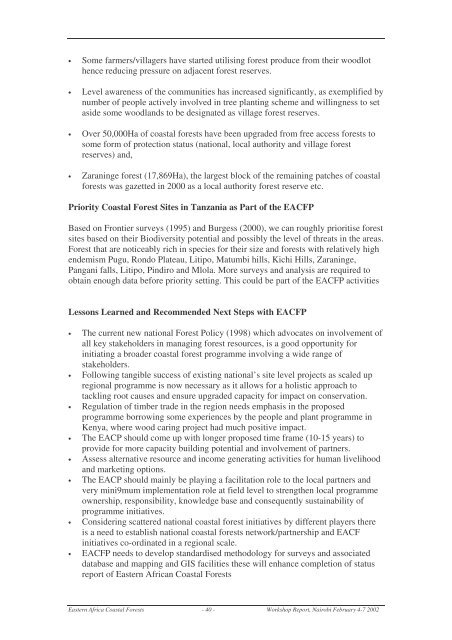Eastern Africa Coastal Forest Programme: Regional Workshop ...
Eastern Africa Coastal Forest Programme: Regional Workshop ...
Eastern Africa Coastal Forest Programme: Regional Workshop ...
Create successful ePaper yourself
Turn your PDF publications into a flip-book with our unique Google optimized e-Paper software.
• Some farmers/villagers have started utilising forest produce from their woodlot<br />
hence reducing pressure on adjacent forest reserves.<br />
• Level awareness of the communities has increased significantly, as exemplified by<br />
number of people actively involved in tree planting scheme and willingness to set<br />
aside some woodlands to be designated as village forest reserves.<br />
• Over 50,000Ha of coastal forests have been upgraded from free access forests to<br />
some form of protection status (national, local authority and village forest<br />
reserves) and,<br />
• Zaraninge forest (17,869Ha), the largest block of the remaining patches of coastal<br />
forests was gazetted in 2000 as a local authority forest reserve etc.<br />
Priority <strong>Coastal</strong> <strong>Forest</strong> Sites in Tanzania as Part of the EACFP<br />
Based on Frontier surveys (1995) and Burgess (2000), we can roughly prioritise forest<br />
sites based on their Biodiversity potential and possibly the level of threats in the areas.<br />
<strong>Forest</strong> that are noticeably rich in species for their size and forests with relatively high<br />
endemism Pugu, Rondo Plateau, Litipo, Matumbi hills, Kichi Hills, Zaraninge,<br />
Pangani falls, Litipo, Pindiro and Mlola. More surveys and analysis are required to<br />
obtain enough data before priority setting. This could be part of the EACFP activities<br />
Lessons Learned and Recommended Next Steps with EACFP<br />
• The current new national <strong>Forest</strong> Policy (1998) which advocates on involvement of<br />
all key stakeholders in managing forest resources, is a good opportunity for<br />
initiating a broader coastal forest programme involving a wide range of<br />
stakeholders.<br />
• Following tangible success of existing national’s site level projects as scaled up<br />
regional programme is now necessary as it allows for a holistic approach to<br />
tackling root causes and ensure upgraded capacity for impact on conservation.<br />
• Regulation of timber trade in the region needs emphasis in the proposed<br />
programme borrowing some experiences by the people and plant programme in<br />
Kenya, where wood caring project had much positive impact.<br />
• The EACP should come up with longer proposed time frame (10-15 years) to<br />
provide for more capacity building potential and involvement of partners.<br />
• Assess alternative resource and income generating activities for human livelihood<br />
and marketing options.<br />
• The EACP should mainly be playing a facilitation role to the local partners and<br />
very mini9mum implementation role at field level to strengthen local programme<br />
ownership, responsibility, knowledge base and consequently sustainability of<br />
programme initiatives.<br />
• Considering scattered national coastal forest initiatives by different players there<br />
is a need to establish national coastal forests network/partnership and EACF<br />
initiatives co-ordinated in a regional scale.<br />
• EACFP needs to develop standardised methodology for surveys and associated<br />
database and mapping and GIS facilities these will enhance completion of status<br />
report of <strong>Eastern</strong> <strong>Africa</strong>n <strong>Coastal</strong> <strong>Forest</strong>s<br />
<strong>Eastern</strong> <strong>Africa</strong> <strong>Coastal</strong> <strong>Forest</strong>s - 40 - <strong>Workshop</strong> Report, Nairobi February 4-7 2002
















